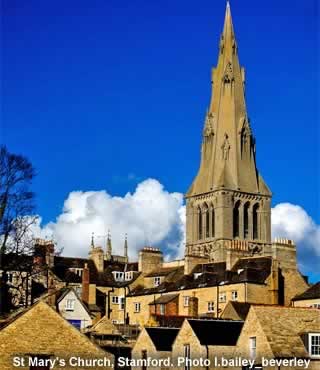Stamford |
|
 |
|||
Britain > East Midlands > Stamford |
||
The finest stone town in England, with over 600 listed buildings |
||
Stamford used to be close to the main road between London and Edinburgh. It received hundreds of coach travellers, who brought good business to the town. Today, Stamford is renowned for its buildings, which retain the old charm of those bygone years. The architecture is mostly from the 17th and 18th centuries. In 1967, Stamford became England's very first conservation area ensuring that its character will be preserved for years to come. Within this single town, there are over 600 listed buildings. This is a higher amount than the rest of Lincolnshire put together! Many of the shops and houses were made using locally mined stone. This is the same material that was used to make Lincoln Cathedral. |
||
Many of the most impressive structures are churches, or other Christian buildings. Despite being a relatively small town, Stamford has over a dozen! One example is Browne's Hospital, which was founded in the 15th century by a wealthy wool merchant. For many years it housed a dozen of the town's poorest citizens. The hospital has managed to hang onto its medieval stained glass, and its original furniture. |
||
An even older church is All Saint's, from the 13th century. It's decorations include the angels carved into its roof, and a representation of the Last Supper. Throughout the church's history, its spire has been climbed by various daring individuals. This isn't a challenge to be recommended though, as the summit is nearly 50 metres from the ground! |
||
Behind All Saint's, there's a narrow street called Barn Hill. Places like this capture Stamford's character perfectly. Their historic look is wildly popular with the makers of films and television shows. Barn Hill has starred in the BBC period drama Middlemarch. Other parts of Stamford have featured in films like The Da Vinci Code, and Pride & Prejudice. |
||
For a full description of the town's history, head for Stamford Museum. Their varied collection includes a small remainder from the town's ancient stone cross, built in the 13th century. More modern exhibits include one of the first oil engines. The museum also houses the Stamford Tapestry, which was made for the millennium celebrations in the year 2000. The 20-foot long piece took 25 embroiderers 17 years to make. Its woollen images depict Stamford's buildings, people and history. |
||
Even after you've left the museum, it still feels like you're walking through an exhibit. The town's streets and alleys just don't feel like they exist in the 21st century. The main area is pedestrianised, so there are no cars. Even Stamford's newspaper, the Mercury, claims to be Britain's oldest. It was first published over 400 years ago, in 1695. |
||
To find Stamford's biggest and best building, you'll need to head a kilometre or two out of town. This is Burghley House, a huge, extravagant place that's often described as the finest Elizabethan mansion in England. It contains over 100 rooms, from elegant drawing rooms to huge kitchens. The house was originally built in the shape of a capital letter "E", in honour of Queen Elizabeth I. Unfortunately the north-west wing is now missing, so the shape is a little different. |
||
The house's grounds were just as carefully designed as the building itself. They were created by the revered 18th century landscape gardener, Capability Brown. Burghley also has two separate gardens. One is full of contemporary sculptures, in a variety of styles. These are set within a backdrop of grass, flowers and water features. The other is the Garden of Surprises, which includes various fountains, and a mirror maze. |
||
|
||
Stamford Museum is open Monday to Saturday from 10am to 4pm. Entry is FREE. Broad Street, Stamford PE9 1PJ. Tel: 01780 766 317 |
||
Burghley House Park is open all year and entry is FREE. House is open from 11am to 5pm (except Winter and Fridays). Entry costs around £12.50 for adults, £6 children. Check for special event closures. Stamford PE9 3JY. Tel: 01780 752 451 |
||
|
Pocket Britain is optimised for use on a smartphone or tablet with internet access. All content is subject to copyright. All reasonable methods have been used to ensure information supplied is accurate at the time of publication. However, it is advisable to check information before relying on it. Privacy Policy |